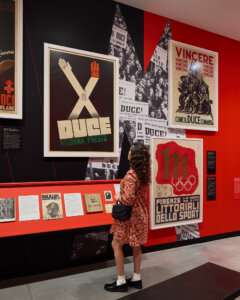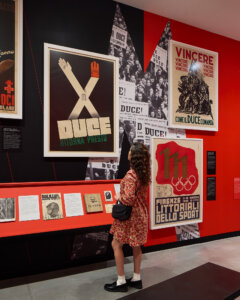Uncategorized
How Mussolini’s Jewish lover changed Fascist art and design

Not even 70 years after Italy unified, Benito Mussolini’s staged march on Rome so unnerved the government that King Victor Emmanuel III named him prime minister, opening the door to Fascist rule. “And so then began the task of selling Italy: at home, abroad, and as an idea in itself,” according to “The Future Was Then: The Changing Face of Fascist Italy.”
Now on view at Manhattan’s Poster House, the exhibition examines the intersection of propaganda and art in Mussolini’s Italy. Featuring 75 works on loan from the Fondazione Massimo e Sonia Cirulli in Bologna and curated by photographic artist and author B.A. Van Sise, the show explores how the regime used bold design, vivid color and modernist imagery to shape the nation’s self-image and fuel the Futurist movement.

But beyond the bombast, the sleek typefaces and arresting compositions lies a deeper, more complicated story. At its heart is Mussolini’s longtime lover and muse, Margherita Sarfatti, a Venetian Jew whose aesthetic sensibilities helped define the visual language of Italian Fascism.
“It’s not a Jewish show, though a person could argue it has a huge Jewish element since everything goes back to Margherita Sarfatti, who’s as Jewish as they come,” Van Sise said. “Fundamentally, Sarfatti’s the core of the show. The entire Italian art establishment changes gears because Mussolini’s girlfriend likes Futurism.”
Born in 1880 into a wealthy Jewish family, Sarfatti became a journalist, art critic and socialite who served as Mussolini’s adviser, biographer and cultural strategist. She funded Il Popolo d’Italia and was, as the exhibition text notes, “the uncrowned queen of Italy.”
“Think Gertrude Stein with better couture,” Van Sise said. “Every single thing in this show exists because of her — the Duce’s girlfriend adored Futurist art, and her taste dictated the direction of Italy’s visual culture. Artists and movements jumped ship to follow her lead, obeying in advance.”
Her influence is evident in pieces such as Marcello Dudovich’s 1936 poster “Esposizione Rhodia Albene alla Rinascente,” which depicts two elegantly dressed women striding in lockstep, evoking Sarfatti’s emphasis on fashion, modernity and movement.
The exhibit unfolds in three sections — “Italy as an Idea,” “Italy at Home,” and “Italy in the World” — each highlighting how Italian identity was constructed through imagery that linked domestic life, political messaging, and global ambition.
“Cioccolato Ali d’Italia,” a poster from 1931, depicts a sleek silver aircraft soaring across the page. Created to commemorate Minister of Aviation Italo Balbo’s transatlantic flights to South America, the image showcases Italy’s growing aviation prowess. A small rendering of Columbus’ ship tucked in the corner underscores the regime’s imperial aspirations.
The 1933 “Ardita Fiat” poster highlights the introduction of the Fiat Ardita, a streamlined, torpedo-shaped car whose name, which means “the daring one,” embodied Fascist vigor. In it a woman sits behind the wheel, her white gloves and black fez hat mirroring those worn by the Arditi, Italy’s elite assault troops.
Van Sise said it was essential to acknowledge the significant, though often overlooked, role Italian Jews played in Fascism’s early years. Among them were Gino Arias, an economist who addressed the National Fascist Party shortly before it seized power in 1922; Elisa Majer Rizzoli, who led the party’s women’s wing; and Guido Jung, an Orthodox Jew who served as finance minister.
“It was really important to include the Jewish history of the Italian Fascist period because it’s partly my own,” Van Sise said. “My family were Tunisian and Libyan Jews who came to Italy, and some branches were old-line Italian families — there for centuries, if not a millennium.”
Eventually Jews were targeted in Italy. By 1938 Mussolini had enacted racial laws, forcing thousands of Jews, including Sarfatti and Van Sise’s grandfather, to flee. Sarfatti spent her exile in Switzerland, Argentina, and Uruguay before returning after the war, only to learn her sister was among the more than seven thousand Italian Jews murdered in the Holocaust.
Van Sise’s grandfather also returned, before the war’s end, and joined the partisans.
He provides the exhibition’s stark coda: a small black-and-white photograph showing the corpses of Mussolini and others hanging by their heels in Milan’s Piazzale Loreto. The photographer was Van Sise’s grandfather.
“It’s a brutal image,” Van Sise said. “But it brings the story full circle — art, politics and identity collapsing into history itself.”
“The Future Was Then: The Changing Face of Fascist Italy” runs through Feb. 22 at the Poster House.
The post How Mussolini’s Jewish lover changed Fascist art and design appeared first on The Forward.
Uncategorized
Rep. Ilhan Omar says Stephen Miller’s comments on immigrants sound like how ‘Nazis described Jewish people’
Rep Ilhan Omar, Democrat of Minnesota, on Sunday likened the Trump administration’s immigration rhetoric to Nazi depictions of Jews.
“It reminds me of the way the Nazis described Jewish people in Germany,” Omar said in an interview on CBS’s Face the Nation, commenting on a social media post by Stephen Miller, President Donald Trump’s senior adviser, in which he suggested that “migrants and their descendants recreate the conditions, and terrors, of their broken homelands.” Miller, who is Jewish, is the architect of the Trump administration’s immigration policy.
Omar called Miller’s comments “white supremist rhetoric” and also drew parallels between his characterization of migrants seeking refuge in the U.S. to how Jews were demonized and treated when they fled Nazi-era Germany. “As we know, there have been many immigrants who have tried to come to the United States who have turned back, you know, one of them being Jewish immigrants,” she said.
Now serving as Trump’s deputy chief of staff for policy, Miller is central to the White House’s plans for mass deportations and expanded barriers to asylum. During Trump’s first term, Miller led the implementation of the so-called Muslim travel ban in 2017, which barred entry to the U.S. for individuals from Iran, Iraq, Libya, Somalia, Sudan, Syria, and Yemen, and pushed to further reduce a longtime refugee program.
Rep. Ilhan Omar: “When I think about Stephen Miller and his white supremacist rhetoric, it reminds me of the way the Nazis described Jewish people in Germany.” pic.twitter.com/GAjIMqFq26
— Aaron Rupar (@atrupar) December 7, 2025
Miller’s comments echoed similar rhetoric by Trump after an Afghan refugee was accused of shooting two National Guard members near the White House last month, killing one.
Trump told reporters at a cabinet meeting last week that Somali immigrants are “garbage” and that he wanted them to be sent “back to where they came from.” The president also singled out Omar, a Somali native who represents Minnesota’s large Somali-American community. “She should be thrown the hell out of our country,” Trump said.
In the Sunday interview, Omar called Trump’s remarks “completely disgusting” and accused him of having “an unhealthy obsession” with her and the Somali community. “This kind of hateful rhetoric and this level of dehumanizing can lead to dangerous actions by people who listen to the president,” she said.
The post Rep. Ilhan Omar says Stephen Miller’s comments on immigrants sound like how ‘Nazis described Jewish people’ appeared first on The Forward.
Uncategorized
Nigeria Seeks French Help to Combat Insecurity, Macron Says

French President Emmanuel Macron at the Elysee Palace in Paris, France, Sept. 15, 2025. Photo: REUTERS/Benoit Tessier/Pool
Nigerian President Bola Tinubu has sought more help from France to fight widespread violence in the north of the country, French President Emmanuel Macron said on Sunday, weeks after the United States threatened to intervene to protect Nigeria’s Christians.
Nigeria, Africa’s most populous country, has witnessed an upsurge in attacks in volatile northern areas in the past month, including mass kidnappings from schools and a church.
US President Donald Trump has raised the prospect of possible military action in Nigeria, accusing it of mistreating Christians. The government says the allegations misrepresent a complex security situation in which armed groups target both faith groups.
Macron said he had a phone call with Tinubu on Sunday, where he conveyed France’s support to Nigeria as it grapples with several security challenges, “particularly the terrorist threat in the North.”
“At his request, we will strengthen our partnership with the authorities and our support for the affected populations. We call on all our partners to step up their engagement,” Macron said in a post on X.
Macron did not say what help would be offered by France, which has withdrawn its troops from West and Central Africa and plans to focus on training, intelligence sharing and responding to requests from countries for assistance.
Nigeria is grappling with a long-running Islamist insurgency in the northeast, armed kidnapping gangs in the northwest and deadly clashes between largely Muslim cattle herders and mostly Christian farmers in the central parts of the country, stretching its security forces.
Washington said last month that it was considering actions such as sanctions and Pentagon engagement on counterterrorism as part of a plan to compel Nigeria to better protect its Christian communities.
The Nigerian government has said it welcomes help to fight insecurity as long as its sovereignty is respected. France has previously supported efforts to curtail the actions of armed groups, the US has shared intelligence and sold arms, including fighter jets, and Britain has trained Nigerian troops.
Uncategorized
Netanyahu Says He Will Not Quit Politics if He Receives a Pardon

Israeli Prime Minister Benjamin Netanyahu participates in the state memorial ceremony for the fallen of the Iron Swords War on Mount Herzl, Jerusalem on Oct. 16, 2025. Photo: Alex Kolomoisky/POOL/Pool via REUTERS
Israeli Prime Minister Benjamin Netanyahu said on Sunday that he would not retire from politics if he receives a pardon from the country’s president in his years-long corruption trial.
Asked by a reporter if planned on retiring from political life if he receives a pardon, Netanyahu replied: “no”.
Netanyahu last month asked President Isaac Herzog for a pardon, with lawyers for the prime minister arguing that frequent court appearances were hindering Netanyahu’s ability to govern and that a pardon would be good for the country.
Pardons in Israel have typically been granted only after legal proceedings have concluded and the accused has been convicted. There is no precedent for issuing a pardon mid-trial.
Netanyahu has repeatedly denied wrongdoing in response to the charges of bribery, fraud and breach of trust, and his lawyers have said that the prime minister still believes the legal proceedings, if concluded, would result in a complete acquittal.
US President Donald Trump wrote to Herzog, before Netanyahu made his request, urging the Israeli president to consider granting the prime minister a pardon.
Some Israeli opposition politicians have argued that any pardon should be conditional on Netanyahu retiring from politics and admitting guilt. Others have said the prime minister must first call national elections, which are due by October 2026.


